Avignon photos
Pictures show: Avignon surrounded by ancient wall and towers
Avignon garden
Horloger
Rhone at Avignon
Sur la Pont at Avignon
Oleanders
Huge statue (5 tonnes of lead)
Avignon Popes' Palace
Avignon walls
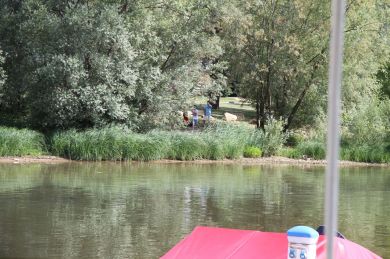














We are off to France from April to October in 2011.
Pictures show: Avignon surrounded by ancient wall and towers
Avignon garden
Horloger
Rhone at Avignon
Sur la Pont at Avignon
Oleanders
Huge statue (5 tonnes of lead)
Avignon Popes' Palace
Avignon walls















We were very keen to visit Avignon but decided not to take Anja the 500 kilometre round trip from Lyon. After the warnings about boat security in Lyon we preferred not to go from there but instead headed back North to Jassans-Riottier and caught a train from nearest railway station, Villefranche, across the river and about 3km by bicycle. The trip to Avignon via Lyon took just two hours; the return trip was three hours because we stopped at more stations but we as a result we were able to get a better glimpse of these towns than we did from the TGV which travels at up to 400kms per hour.
Avignon exceeded our expectations. We admired the walls that surround it, the famous bridge, the Pope's Palace and the gardens on the North (Rocher des Doms) with sweeping views over the Rhone and beyond to the Alps. We walked down to the banks of the Rhone, which flows just beyond the town walls.
Continuing our return North we spent a night in Macon but then were reminded on the difficulty of stopping on this part of the Saone. Our intended stopping place of Tournus was full and we did not find any alternative so we just kept going, ending up at Franges, just inside the Canal du Centre, where we had spent several comfortable days before making the trip South. We were very tired after a 10 hour day during which we covered 71 kilometres, a record day for us but one we do not want to repeat if we have any choice. There were, however, only two locks. Over the next two days we made our way to St John de Losne, back to where we bought Anja last year.
Pictures show:
Avignon surrounded by ancient wall and towers Avignon garden Horloger Rhone at Avignon Sur la Pont at Avignon Oleanders Huge statue (5 tonnes of lead) Avignon Popes' Palace Avignon walls
Best Regards, Penny and Dave
Pictures show various aspects of Lyon:
Notre Dame basilica (high above the city) Lyon Horlogue 150AD foundations of oldest Christian Church outside Rome Huge fountain symbolising the four great rivers of France (the horses) Lyon Opera House Old organ- St Nizier St Nizier Church









Lyon is the biggest city (1.8 million) we have visited in Anja. We were worried because each of our sources of information informed us about the lack of security there, with warnings not to leave boats unattended unless there were other skippers around to keep an eye out. After our experience at Chalon where we could find nowhere to tie up, then having David's phone stolen in Jassans, we were quite apprehensive as we cruised down the Saone towards its most Southern point, and the most southerly of our destinations.
Entering Lyon we were rather surprised to see kilometres of good quays lining the banks of the riverfor over 5 kilomtres, altogether different from Chalon. Most quays had good vertical sides and well- placed rings and bollards. Some had commercial barges tied to them but, except in an old and crowded port area, there was just one recreational barge there. We were about to tie up near it when we saw a "no mooring" sign so we continued to the end of the Saone and into the Rhone, looking for possibilities.
We tried the new Port de Plaisance but with no success. The Capitaine thinks that the planners got their figures wrong. Most boats wanting a mooring are over 12metres, the maximum pen size. The place sits virtually empty while he turns away potential users because they are oversize. If you are lucky you might get one of two spots at the end of an arm, but both were taken when we checked yet there was only one "correct" sized boat there.
In continuing our tour down the rivers we found a fuel barge and a chandlery so filled up with diesel and replenished supplies of our household (red) diesel. There was a chandlery attached, which was also most welcome. It was bigger and cheaper than the ones we intended to visit in St Jean de Losne so we bought some more hard fenders and long line needed for towing through some of the tunnels to the North of us.
As we headed North back up the Saone were were delighted to find that two boats had tied up at Quai du Mal Joffre, a long quay right in the middle of town. We joined them there and by night there were half a dozen barges along the quay. All were staying a couple of days so we had created our own secure environment. It is amazing that we can go into the centre of a large town and tie up right in the middle. A legacy of when everything was centred on the rivers. We had "Old Lyon" on one bank and "New Lyon" on the other bank.
After a quiet and peaceful night we explored Lyon, a handsome town with tall, impressive buildings including an opera house in the main part of the city on the East bank and on the West Bank "Old Lyon" dating back to the town of Lugdunum established by the Romans in 43BC on the top of the hill near the river. We caught the funicular up there, an experience in itself. The remains of Roman buildings are still quite obvious and in fact the amphitheatre was being set up for a performance while we were there.
There was a marvellous old clock in the Cathedral. From memory, it was over 500 yesars old. It was capable of playing about a dozen long tunes and also had figurines which danced and played at certain times of the day. A most amazing instrument and still in full working order.
That afternoon we had an SMS to tell us that our first grandchild, a daughter had arrived. Our daughter Wendy had finished work three weeks early to have a break and prepare for this wonderful event, but Mary came after six days including the long weekend! Still at 3.3kgs she is a good size and the birth went well. Penny can't wait to cuddle her when she arrives back on July 2nd for a two week "baby" trip.
As this was the turn around spot for Anja, we headed back up to Jassans-Riottier, pleased that we had not cancelled our plan to visit Lyon.
Pictures show various aspects of Lyon:
Notre Dame basilica (high above the city)
Lyon Horlogue
150AD foundations of oldest Christian Church outside Rome
Huge fountain symbolising the four great rivers of France (the horses)
Lyon Opera House
Old organ- St Nizier
St Nizier Church
Best Regards,
Penny and Dave
The water levels on the Saone River between Chalon and Lyon have been altered by various works such as lock replacements. As a result, the old river bank is now high and dry, a good place for grazing cattle or having picnics but leaving many towns with handsome stone quays with rings and bollards high and dry and useless as stopping places for boats. Some have installed pontoons in the deeper water, often with power and water available. One such place was the tiny town of Jassans-Riottier and here we stopped after leaving Macon.
Near Jassans is the tiny town of Ars, which became known through the work of the "Cure of Ars", St John Vianney, who ministered to its people for 41 years and who drew many pilgrims there during his lifetime because of his wisdom and goodness. As we had for 10 years lived in the Parish of St John Vianney in Canberra, we were keen to see the village so cycled the 7 kilometres there and were able to see where he lived and died.
Back at the boat David suffered the first theft of his life when five 12- 14 year boys climbed onto Anja and stole his phone. David had been looking up something on it put it down in the cabin to see what they were doing. They asked retrospectively for permission to come aboard to look more closely and he agreed expecting them to stay on deck, but they trooped into the cabin, asking lots of questions and playing with the wheel. Very soon we were too uncomfortable with this and bade them farewell. David then wanted to go back to what he had been doing and we immediately realised that they had lifted his phone. He grabbed his bike to catch up with them but they were long gone. The gendarmes were called and looked around but really there was never any hope of finding them with the phone as they would have secreted it I am sure- and in fact perhaps only one of them knew anything about it.
We usually would not let strangers aboard our boat but were lulled by the age of the kids into dropping our usual guard. Never again - a lesson learned the hard way. The theft made our lives difficult in many ways because this was a very smart phone being used for much else beside making phone calls (i.e. posting these blog entries).
Photos show: Swan with babies Ars Basilica John Vianney's kitchen
plus some others: Hospital at Chalon sur Saone (on the island) Macon bridge (14th Century) at night Very large ship turning near us
Town of Travaux Over laden barge almost sinking The River Saone
Best Regards, Penny and Dave









14th Century wood house.
Carving from wood house.
Anja and Sundancer 2 rafted together.
Rainbow at Macon.
Kids stage an event nearby but it gets washed out at the start.
Pont St Laurent (built 15th Century!)- Macon.

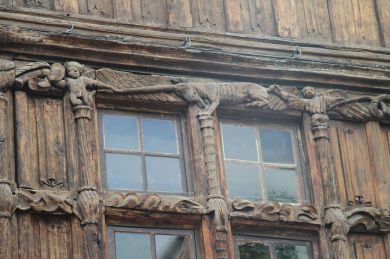




We turned from the Saone River into the Seille, a small but navigable river 39 kms long, with four locks. The first lock is manned but the other three are operated by the user, our first experience of "doing it ourselves". We were pleased to have Penny's sister Annette as a third member of the crew as most often the locks were the "wrong" way when we arrived, so that we had lots of gates to open and levers to turn. Being able to operate both port and starboard lock gates at once saves time as well as energy. David usually helps with them if we have a lock- keeper, but he was too occupied driving to be able to lend a hand until Anja was tied up in the lock. Once there, he was quick to help but sadly this has left him without his prescription transition long distance glasses which fell off his face as he leapt from boat to lockside.
They went straight to the bottom and there would be no hope of finding them in the silt. He did briefly contemplate diving in the lock, but it would have been too dangerous and also rather unhealthy. Fortunately his optometrist was able to email the prescription which was instantly understood by the optometrist in Macon, even though she did not speak or read English. The new pair will be ready in a week and he will get a spare pair too. This was probably the biggest test to date of David's French speaking skills. We will see in a week if his message was fully understood.
Along the Seille River the real attraction is the peaceful rural environment. The river flows past farms and tiny villages and even at its peak only carried sand barges. We watched a farmer bring in his bales of hay and were stared at by numerous cattle, unusually not all Charolais. There were many fishermen and we were fortunate to pass one casting his nets. He used very much a French-style fishing boat of old, with a large pole in the bow. From this, arms like the spokes of an upside-down-umbrella were deployed with the arms holding the net into shape. He would lower the net using a small winch and pole or paddle the boat before raising the net.
One of the main products of the area is grain-fed chicken so we saw fields of poultry scratching around in the grass or nesting in trees.
There are several small towns including Cuisey, which our guidebook tells us is the fourth book village in France. Charite sur Loire was another "Book Village" full of shops selling old and valuable books, and a gathering place for book lovers who hold a fair once a month. Thousands of people attend the monthly Cuisey fair.
At the end of the river is the main town of the area, Louhans, a 5th century town mainly noted for an architectural feature- it boasts 157 "arcades" in its main street, a very broad verandah in the front of each shop, dating from the 16th and 17 centuries, many beautifully decorated. We spent an interesting lunch time in Louhans but did not visit the other towns. This canal is very popular with hire boats and they take up most of the available moorings. We were quite content to spend two tranquil nights along the river bank.
Pictures show: Eclusiers Annette and Penny Stopped for the night Peaceful Seille Arcades at Louhans Traditional polychrome Burgundy roof tiles Gathering the hay before the rain Old Mill Cinder Heron Fishing Mum and Baby Swan and babies
Best Regards, Penny and Dave


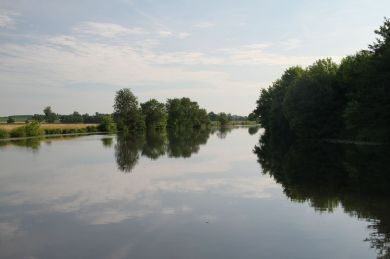



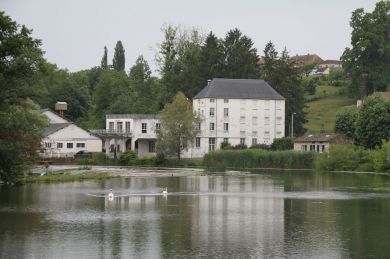




The last lock on the Canal du Centre is 10.8 metres, our deepest to date. It differs also in having a lock gate which folds upwards and which is the only non- automatic lock on the Canal du Centre. David had applied the final coat of marine enamel to the aft roof a short time before going through the lock. This was a bit of a problem as we had to pass under the huge, dripping gate. However, we waited as long as possible and the drips were not too bad for the roof.
Very soon we were turning onto the Saone River, our first river since we left the Seine five canals ago. We almost felt lost in this broad expanse which is several hundreds of metres across but soon realised we needed our wits about us as we came across huge commercial barges carrying freight and equally huge passenger boats several storeys high. Anja likes the broader expanse and goes much faster with the same engine revolutions. Also, there are only 5 locks in the 142 kilometres between Chalon and Lyon, so we will be able to move along without too many interruptions. The passenger ships are about 140metres long and we even encountered a push-tow combination of two 140metre barges (ships, really, at 5,000tonnes each) linked together to make a 10,000tonne 280metre long ship. We were in a little bit of trouble at the first Saone lock because Penny, the "on deck person" was not wearing a life jacket. So, we got a bit of a roasting over a very loud public address system from the eclusier who sits in a control tower.
Our first night on the river was spent at Tournus. On the canals we had become used to finding overnight spots without too much difficulty but here on the river there are more boats and fewer suitable stopping places. Tournus was an example: we ended up with our front half attached to a pontoon and the stern tied to a pylon almost under a bridge. Still, the town was worth it, with many very old houses, a monastery dating back to the 6th century and a well- preserved Hotel- Dieu. The museum displays remnants found locally and going back to the paleolithic age. Of particular interest to us was a bronze helmet from 900BC. It was very handsome and in excellent condition. The wearer must have had a very strong neck.
From Tournus we turned into the Seille River, then back on the Saone to stop at Macon, another ancient town with old churches and a fascinating museum. At Macon we could not see any space on the quay so gratefully accepted an offer from a bigger barge to raft up along side him. Half an hour later, along came Ian and Helen Potter on Sundancer II, an Aussie yacht,fellow memebers of the Coastal Cruising Club of Australia. With no obvious mooring for them either, we sought and were granted permission for them to raft up too. Ian and Helen have been travelling around the world and are now making their way through France from the Mediterranean to the Atlantic. We have been in touch by email so it was not altogether a surprise to meet up here, but we did not expect to actually have a raft- up of CCC members for the June long weekend on a river in the South of France.
At Macon we farewelled Penny's sister who caught the TGV which took 1 hour and 40 minutes to travel over 400 kilometres to Paris.
Photos show:
140m cruise liner Tournus The Saone Tournus main street A biggie! Eglise St Valerian 11th Century Eglise St Philibert Wood carving circa 1400 Beautiful organ (just missed the free recital) Hotel de Dieu (commenced 17th century) Book of hours 14th Century Bronze helmet 3,000yrs old from river bed Swords from over 3,000 years ago (from river) 10.8m lock Canal du Centre
Best Regards, Penny and Dave














Hi everyone,
Here are some more photos.
We had seen a strange, half-sunken, steel device at the side of the canal. It looked a little like a boat, but was a very strange shape and with holes in unusual places. Then, at Fragnes, they had this brightly coloured object on display. It was the same as what we had seen. Here it is. The explanation was revealing. It is a floating lock gate that can be towed and winched across lock gates, then sunk. Basically, it forms another lock gate in front of the normal working gates and thus enables work to be done on the locks and lock gates without draining that section of canal. Ingenious, and now we know!
Also from Fragnes, is the large covered "town square" about 50 metres from where we stayed on the boat.
Other photos show aspects of Chalon sur Saone, the large island which is part of the town (with a hospital and many houses) and some photos from the interesting photography museum. Photography was invented here.
The carved tree is 400 years old but carved in 1986.
Best Regards, Dave and Penny












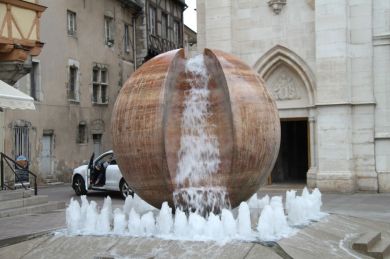

We have made our way downwards on the Canal du Centre, heading for the Saone at Chalon sur Saone. This is a very active trip with 34 locks in 48 kilometres, all automatic. Many of the drops are over 5 metres. the countryside is mainly rural and is most picturesque at Santenay where our overnight stop gave us a panoramic view of the grape-vines in the Southern part of the Cote de Beaune wine- growing area.
On the last leg of this trip, we finally had a day of rain, with the temperature falling to 12 degrees. After 11 locks Penny was wet and cold, very pleased to tie up just before the end of the Canal, at Fragnes where there was an attractive quay in the centre of a tiny and very modern village. Instead of the old stone buildings we are used to, the covered area which serves as the Town Square is a large open area with a steeply pitched roof, much more like the community buildings in the Solomon Islands or New Caledonia than what we are used to in France.
There is a bus service which allowed us to go into Chalon. We wanted to explore the city and to check out the moorings there, as we are to meet Penny's sister who is spending some time with us after a meeting in Rome. Sadly there is nothing there for us. The town quays are too steepand deep and the bollards very far apart; we are too big for the Port de Plaisance which has a 15 metre limit. So we will stay at Fragnes.
Chalon is yet another ancient town, chosen as the supply centre for Julius Caesar but settled long before. It was also the birthplace of Nicephore Niepce who invented photography so we enjoyed a visit to the Museum devoted to photography. It included some of his original images and other inventions. We also visited the arcitectural museum which outlined the development of the town over thousands of years.
The bus service which made this trip possible is worth mentioning. There is a bus timetable, but it is necessary to ring to book two hours before one wants to travel. If there are not enough bookings for the bus, a taxi is sent but the price is maintained at 1 euro per person. We had a taxi each way, just us on the way there, with one other person on the way back. All for two euros each.
Fragnes itself is a pretty and quite modern town. It has only a boulangerie (plus coiffure and restaurant) but a truck comes with limited groceries each day, and there is a large supermarket and a hardware store a bike ride away. David has been able to stock up with bits and pieces he has been wanting. The first trip was to buy tubing to repair a leak in the injector spill rail line which had developed during the final days of the trip up the canal. This leak emptied 40litres of diesel fuel into the bilges. He had to collect it, then work out if it was white (propulsion) diesel or red (heating diesel). Then came the process to find the leak.
The painting of the back roof is now almost complete but there are millions of tiny bugs with a death wish plummeting into the paint. Fortunately it was worse on the undercoat than on later coats. During his time on the roof David was entertained by parachutists and aerobatics planes flying from a nearby airstrip. This is (we think) to commemorate D-Day. Another distraction was a day for children with a disability. They arrived at the port as passengers in the sidecar of motorbikes and then were kitted out with life jackets and helped into motor boats for a ride on the canal, followed by some refreshements. There were children coming in batches all day Saturday, with many adult helpers to ensure the smooth running of the day.
One day of the air show was also set aside for these children. An imressive effort from all the people involved.
Next, we exit the Canal du Centre through a lock with a large drop of 10.7metres. Then past Chalon and on the Saone to Tournus. After that, we will divert along the Seille River and back, thence to Lyon.
Best Regards,
Penny and Dave
Each day we travel we need to plan ahead to decide where to spend the night, the eternal problem for nomads. Often there is a town or village which we are keen to visit. At other times it is more a matter of finding a safe and convenient mooring en route to a destination. Because it is necessary to give the eclusiers information about when and where we are stopping for the night, we need to plan ahead.
Many villages have provided a "Halte Nautique" with bollards and a grassy bank, sometimes with electricity and water provided. These are very pleasant places to spend the night in a rural setting and are a perfect place to spend a night. In larger towns the moorings are often more controlled and it is more common to charge for the night's stay. The price so far has varied from about 8 euros to 20 euros. Often electricity and water are an additional expense. In some towns one can choose to stay free without extras or pay to have them. We are fairly self- sufficient for electricity and have large water tanks so we do not need to seek the paid stops. On average we have paid for one night each week.
The canal guide typically shows where there are bollards, quays and "ports de plaisance" (marinas) as well as features of the town or village close by. We have not found any area to be so full that we could not fit in. No doubt as the summer progresses we will experience this problem.
At times no proper stopping place is available but it is possible to find an isolated bollard or simply a grassy bank that we can put stakes into. The stakes need to be hammered in very hard if there is much traffic expected. Last year we found ourselves pulled off the bank by a hotel barge becaseu the water is sucked out as a heavy barge progresses. This year we have stronger stakes (about 8 times the holding strength), put them in with more vigour and where possible choose a spot where there is a tree or stump we can tie to as well.
David always prefers to be near a village where there is a boulangerie so that he can get his morning fix of baguette. Failing that we have to plan our lunchtime stop with care so that he can get the bread then. Fortunately the canal guide indicates which villages have boulangeries. It is up to David to follow his nose and the trail of 7am shoppers to find the actual premises. He often brings the bread back still warm from the oven. What a delight.
Attached are a few pictures of stopping places. The best so far was Santanay, with a panoramic view to a 500m hill covered in prestige grape vines.
Best Regards,
Penny and Dave

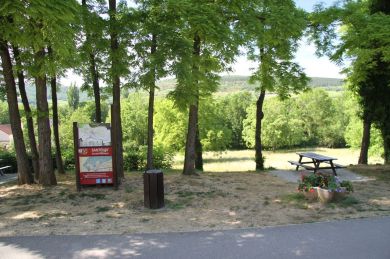

We have been out of decent internet range for a week, but now we are near Chalon sur Saone, we can add the information.
In Digoin we merged seamlessly onto the Canal du Centre, built at the end of the 18th Century to connect the River Loire with the River Saone. It rises quite quickly to a summit of 301 metres so locks are frequent- 61 locks in 112 kilometres. So far all of these have been automatic. For some there have been eclusiers around, at other times we have been left to operate them ourselves. We have appreciated that the bollards are close to the edge of the lock, whereas in the previous canals this year, they have been a long way back from the edge, making it difficult to attach the lines especially in the deep locks. The hard part of the Canal du Centre locks is trying to reach the pull chain to start the lock operation. All are placed in very inconvenient spots too close to the back and front gates to allow us to tie up comfortably and still reach them. We have evolved a way of doing it with the boat hook which mostly works. Even though this used to carry a great deal of commercial traffic, mostly from the coal mines along the way, the surroundings of the canal are very rural. This is also the place of origin of Charolais cattle and they are much in evidence.
Our first stop was in Paray- le- Monial at a spot where plane trees lines the canal. This was a suitable introduction to the first "Four Flower" town we have visited. Even very pretty towns before have achieved only three flowers. so this was something special and well deserved. There were flowers everywhere. The roses were spectacular. There public spaces were all carefully groomed and tended. The Basilica is outstanding, with the interior featuring honey- coloured stonework rather than the usual grey. It was started in the 11th Century with one tower almost the same as the other but with deliberate differenc es. They were built 100 years apart. Spot the difference in the photo! The town is a place of religious pilgrimage because the devotion to the Sacred Heart began here.
We always study the War Memorials in the towns we visit. In Paray-le- Monial as in many places, those who died in the Second World war are broken up into categories- died in deportation; resistance fighters; civilian dead and so on. This time there was an extra entry: those who died on August 22 1944. We asked about it at the Tourist Information Centre but the young man there did not know, so we put it aside for later research.
The answer was forthcoming the next day. We travelled to Genelard which has a Museum about the World War II demarcation line between "Free" and Occupied France. The line actually went through here, often dividing farmers' fields from their houses, children from their school and one branch of the family from another. There were documents, photos and stories about the demarcation line, the effect on everyday life and about those who subverted it by smuggling people and mail from one side to the other. We asked here about August 22 1944: this was the period when the Resistance, emboldened by allied successes on and after D Day (June 6th 1944) set about freeing French towns and cities from the Germans. Paris was freed on August 25th, Auxerre on August 24th, Dijon on September 12th. However, the actual event at Paray- le Monial was a specific action by the local townspeople to try to free deportees from a train travelling though their town. There was a train nearby carrying SS soldiers, so many people were killed.
The next day's trip took us under three canal- level bridges which needed to be raised to allow us through, in the middle of Montceau les Mines, a busy town. We had read, and been reminded by the eclsuer at the last lock, that the first was automatic, initated by pulling a cord overhanging the centre of the canal. We had met such cords before and they were easily operated, usually hanging from an arm extended out from the starboard side of the canal. We were looking out for such a structure but could not see one then remembered a gantry over the canal 400 metres back with something dangling from it but so high that surely it was not what we were looking for. Still, nothing else was in sight and the canal lights were red, indicating that we could not proceed, so we backed up to it. There was no way Penny could reach it. In the end David had to climb on the roof and a ladder to be able to reach and pull the chain. After this there was a long delay and we were still wondering if this was in fact the trigger for the bridge. After many minutes, we were relieved to see the boom gates go down to stop the traffic and then the bridge started rising, reminiscent of the Spit Bridge. We passed under it uneventfully to see another bridge opening in front of us. This was controlled by a bridge keeper. The third bridge was a pedestrian bridge and the whole span lifted horizontally to allow us through.
The rest of the rise to the top of the canal was uneventful so we stopped at Montchanin to savour the completion of the first half of the Canal du Centre. This was actually one of the dullest towns we have been in and baguettes were not readily available, but David had the chance to do some significant work on our back roof, his current major project.
Pictures show the Paray Basilica, Paray War Memorial, Demarcation Line memorial by the Canal, Montceau Bridges, general canal and the famous Charolais cattle grazing by the canal as we passed.
Best Regards,
Penny & Dave



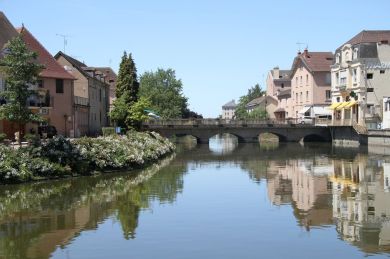

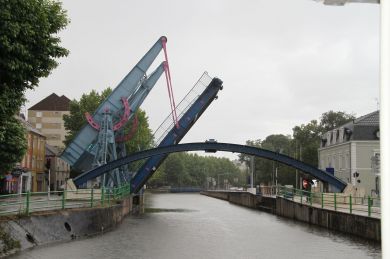
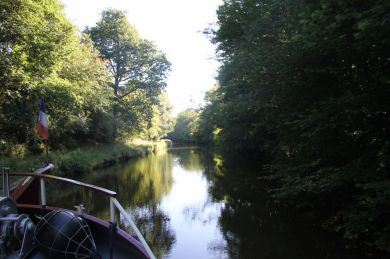

Val & Mike: Congratulation to the Grandparents and of course to the new Parents on the arrival of dear little Mary (06/23/11)